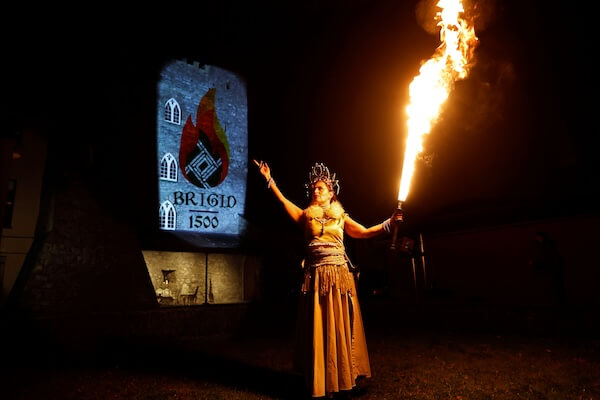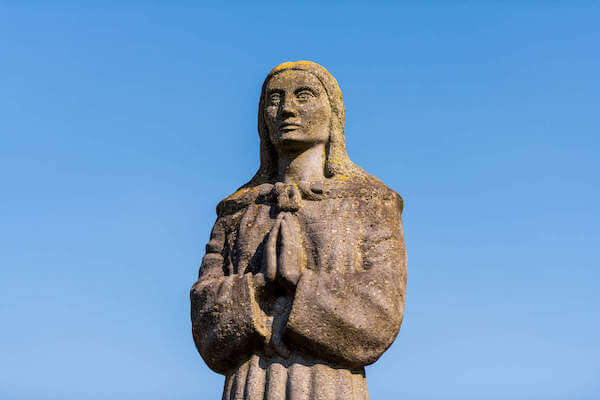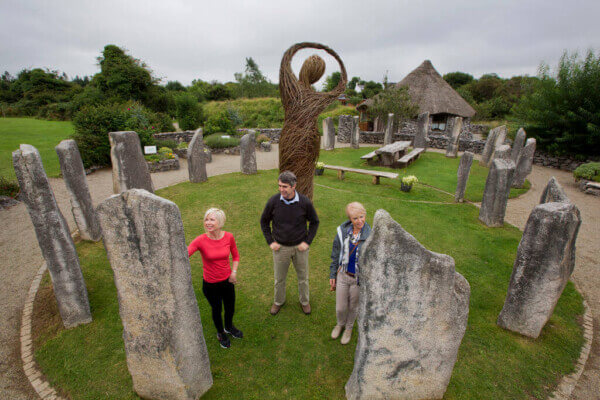While Saint Patrick’s Day is known the world over as March 17th, a day that is dedicated to Ireland’s patron saint, Patrick, Ireland’s female patron saint, Brigid, has remained in the shadows, at least to an international audience.
 This post and page contain affiliate links and I may earn compensation when you click on the links at no additional cost to you.
This post and page contain affiliate links and I may earn compensation when you click on the links at no additional cost to you.
Otherwise known as Saint Brigid of Kildare, the life of this early Christian nun is celebrated in Ireland each year on Feb. 1, which marks her feast day.
It is a day that is also associated with the pagan festival known as Imbolc, a popular event in pre-Christian Ireland that worshipped the Celtic pagan Goddess of Fire known as Brigid.
In Christian Ireland, the day eventually became known as Saint Brigid’s Day, with people in towns and villages across the country making Saint Brigid’s crosses woven from rushes in her honor.
Doll-like figures were also created and were brought from house to house by young girls.

Saint Brigid, who is believed to have been born in 451 AD in Dundalk, Co. Louth, to a Christian slave baptized by Saint Patrick and a father who was both a pagan and a wealthy chieftain in Leinster was truly revered in Old Ireland.
Most Irish people over the centuries believed that by worshipping her, their homes and livestock could be protected.
Shop for a Variety of St. Brigid's Crosses & Jewelry on Etsy
Honoring Brigid in Modern-Day Ireland
In recent years, the importance of Saint Brigid has been elevated and brought to a new generation with the creation of HerStory, a multi-disciplinary storytelling platform that celebrates female role-models.
The feminist organization has campaigned for a national holiday, similar to Saint Patrick's Day, and in 2022, the Irish government agreed to add a new bank holiday to the yearly calendar, which will be celebrated on Feb. 8.
As in past years, HerStory has drawn national and international attention to Brigid through a series of colorful displays on many of Ireland's landmark buildings as well as sponsoring a number of musical and cultural events.
This year's HerStory theme is based around the old saying, “There's room for everyone under Brigid's cloak.”

In collaboration with Kildare County Council, events have been organized through Feb. 6th to celebrate the 1,500th anniversary of Brigid's death around 524 AD.
On Saint Brigid's Eve, Jan. 31st, the Newbridge Town Hall in Newbridge, County Kildare, will take center stage as a beautiful HerStory light show is reflected on the building.
Other entertainment includes a fire-dancers performance, a Wicklow Willow weaving workshop, and a performance from the Newbridge Gospel Choir.

The Hill of Allen, the highest point in Kildare, is also expected to be lit up on Brigid's Eve.
The celebration of Ireland's female saint will continue on her Feast Day, with light shows at the Potato Market in Naas as well as the New Naas Library. More details on the Saint Brigid Kildare events can be found at the Kildare Heritage Centre website.

Other well known landmarks across Ireland will also be bathed in the HerStory light show, including Doonagore Castle in Doolin and Bunratty Castle.
At the Imbolc International Music Festival in Derry, the legacy of Brigid will be embraced during the Brigid 1500 Concert, which also celebrates the creative contributions of women to arts and culture.
Get Wifi in Ireland with Wifi Candy – take 10% off with code IOB2024
Tourist Attractions Honoring Saint Brigid
It is fitting that most of the celebrations honoring Brigid's life are taking place in County Kildare.

It is where she founded a monastery for both men and women.
As a result, it became an important center of religion and learning, in addition to being a place where metalwork and illumination were taught.
An important illuminated manuscript is said to have been created at the monastery — similar to the Book of Kells — but we will never know since it has been lost for centuries.
Saint Brigid’s Trail in Kildare traces the history of this pious woman, who was known for giving to the poor.

The trail, which takes about two hours to complete, starts at the Kildare Heritage Center (once an 18th-century market house), where you can watch a film about Brigid’s connection to the town.
It continues to St. Brigid’s Cathedral (built on the site of the monastery). The west windows of the nave show Saint Brigid helping the poor and making her religious vows.

Behind the cathedral is a round tower built in the 12th century and to its north are the restored foundations of an ancient fire temple.
In pre-Christian times priestesses are believed to have held a perpetual fire to the goddess Brigid.
The local Saint Brigid nuns carried on the tradition until two bishops tried to have it extinguished. It was eventually put out during the Reformation and only lit again in 1993.

The trail continues south toward St. Brigid’s Parish Church, which was opened by Daniel O’Connell in 1833.
The main church doors contain six bronze panels each bearing a Saint Brigid cross.
At the altar, eight stones were cut to form another Brigid’s cross. There are many more tributes to the saint in this beautiful church, including an interior shrine.

Also included in the trail is the Solas Bhride Centre and the ancient St. Brigid’s Well, where you’ll see a statue of Brigid with a bishop’s staff in her hand, lending to the belief that some think she may have risen to the rank of bishop while in charge of the Kildare monastery.
Other Places in Ireland that Venerate Saint Brigid
Since Brigid was born in County Louth, so it’s no surprise that she is remembered there.
Located about 15 minutes from Dundalk, you will find a shrine and a well in her honor.
The shrine has stones that are said to heal head, back, and knee ailments, and another stone that is always wet is said to bless the eyes.
Legend says that Brigid drew water from this well, hence its popularity among people who seek solace and healing.

A well in Liscannor in County Clare is also dedicated to Saint Brigid. It is one of the oldest wells in the country rumored to have healing powers.
Other holy wells and shrines exist in Counties Cavan, Donegal, and Westmeath.
Brigit’s Garden in County Galway also pays homage to Ireland’s female patron saint. The garden evokes images of Celtic heritage and mythology and is well worth a visit.

The award-winning gardens are known as one of the most spectacular in Ireland containing 11 acres of native woodland and wildflower meadows.
There’s also a nature trail there, as well an ancient ring fort, otherwise known in Ireland as a fairy fort, a thatched roundhouse and crannog, and a calendar sundial, the largest in the country.
Do the legends of Saint Brigid resonate with you? Are you named after the saint or perhaps a relative is? Let me know in the comments below.





St.Brigid has great meaning for me. She appeared to me in a dream when I was a child. Since I’ve grown up, my life has brought me back to her. She has so touched my life. When I was at a low point in my life and suffering, I knew she was there holding my hand. She is a great soul–a bringer of light to those who seek it.
How wonderful, Michael. Glad to hear she has a special meaning for you.